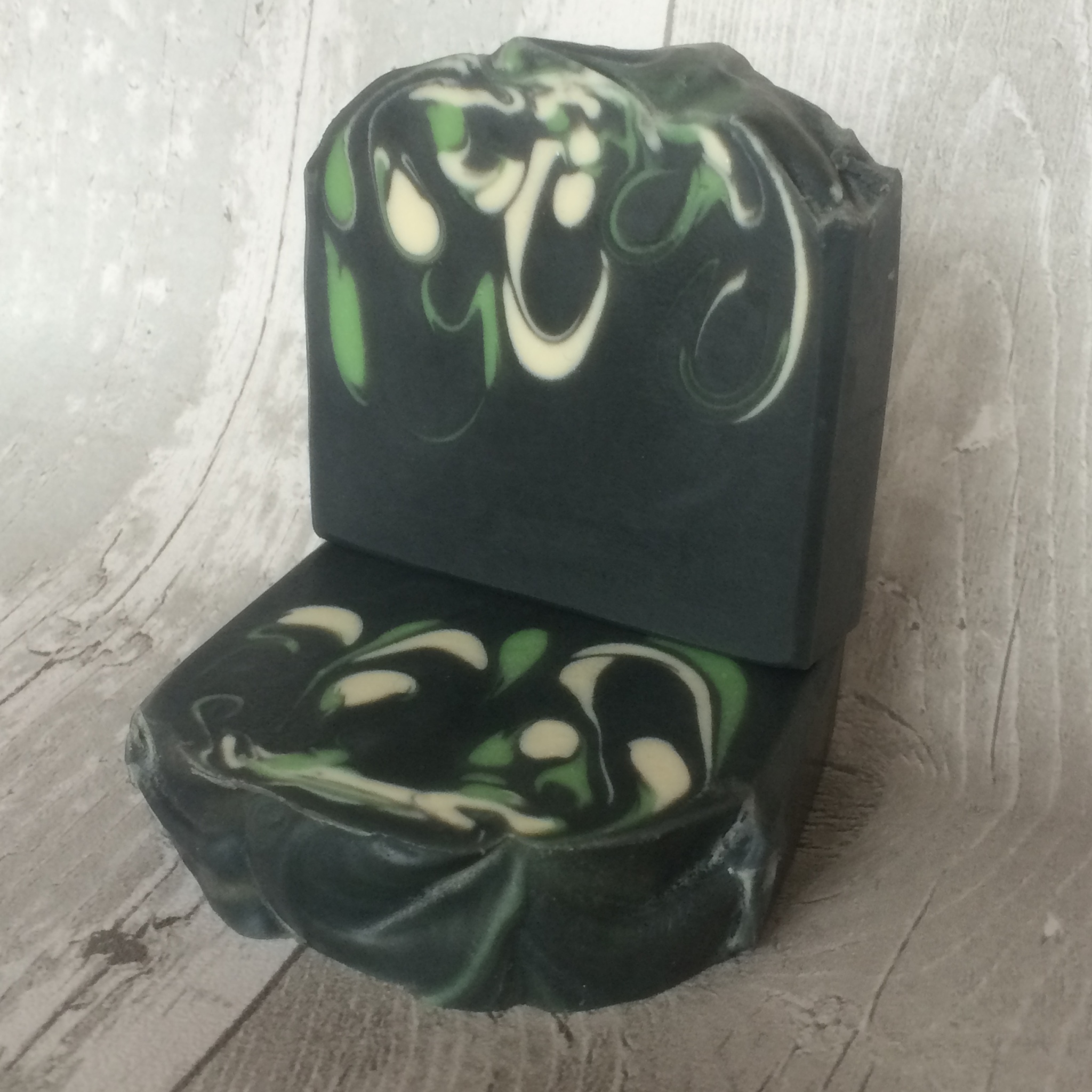…that is, what goes into my soap, and why. I’m often asked what my soaps are made from. Well, the ingredients in my soaps are no secret – they’re clearly labelled on each and every bar that’s sold, so here goes 😀
Fact is, you only need THREE ingredients to make soap. A vegetable or animal fat of some kind, sodium hydroxide (NaOH) (aka Lye) and water. The sodium hydroxide is combined with the water to create a lye solution, which is then mixed with the oils or butters. The sodium hydroxide combines and reacts with the fatty acids in the oils and/or butters and hey presto, you get soap, (plus, by the way, glycerine. I’ll come to that later).

Take, for example, a bar of my Clarity essential oil soap (above). The ingredients, as they appear on the label, are as follows:
Sodium Olivate, Sodium Cocoate, Sodium Shea Butterate, Sodium Avocadoate, Sodium Cocoa Butterate, Sodium Castorate, Glycerine, Aqua, Salvia sclarea (Clary) Oil (Sage essential oil), Cymbopogon schoenanthus Oil (Lemongrass essential oil), Activated Charcoal, Titanium Dioxide (Ci 77891) & Micas *linalool *citral (*naturally present in essential oils).
Let me clarify:
All my bars contain six different oils and butters: Olive Oil, Coconut Oil, Shea Butter, Avocado Oil, Cocoa Butter and Castor Oil. Bear with me here – small chemistry lesson coming up. If the soap is made properly, there will never ever be any sodium hydroxide present in the final bar, and so it isn’t necessary to put it on the ingredients label. However, the sodium hydroxide has caused the oils and butters to change – into soap – or, chemically speaking, into ‘salts’. This is why the first six items on the ingredients list are all ‘Sodium (insert name of oil)ate’ ie, they are all salts formed from the original six oils/butters combined with sodium hydroxide.
So why those particular six oils and butters? I use coconut for it’s ability to give soap a great, abundant lather, but it can be drying to some people’s skins and so I temper it with plenty of olive oil which produces a mild, gentle soap. Cocoa butter contributes to the hardness of the bar, whilst also being moisturising. Avocado oil and shea butter are considered to be luxury additives – they don’t contribute to the lather or the hardness of the bar, but they are extremely moisturing. They’re probably the reason my customers say they don’t need hand cream after washing with my soap!
I decided long ago not to use animal fats in my soap. I don’t have a problem with animal fats per se – I’m not vegetarian, and I know from my early days of soapmaking and experimentation that lard makes wonderful soap. It was just a decision I made early on in my recipe development, and I’ve stuck with it. Similarly with palm oil, I used it in my early soapmaking, but haven’t done for years. I have no problem with other producers using palm oil – each to their own – but it’s not for me.
Next on the list you’ll see glycerine. Glycerine is a by-product of that chemical reaction between the NaOH and the oils/butters. It’s often extracted during the commercial soapmaking process, as it’s a valuable commodity and can be sold on to other manufacturers. In handmade soaps though, it goes nowhere. It stays within the soap and acts as a humectant, drawing moisture to the skin and helping skin retain moisture. (Note, it is NOT a moisturiser, as I’ve seen claimed elsewhere)
Next comes Aqua (water). Water is needed to create a solution of the NaOH. That’s its only purpose. Once the soap is made, we soapmakers leave the soap to cure for weeks on end, drying out the soap and trying to get rid of as much of the moisture as possible.
The next two items on the list are simply the fragrance – Sage essential oil and Lemongrass essential oil. Some soapmakers claim that essential oils added to soaps have therapeutic properties above and beyond the fragrance, but there is some doubt as to where these properties survive the chemical process. Anyway, without extensive and expensive laboratory testing, making such claims is misleading.
The next three ingredients – Activated Charcoal, Titanium Dioxide (Ci 77891) & Micas – are colourants. The first two are natural, the mica has colour added to it in a lab, so can’t be considered natural.
Finally we come to the last two starred items: *linalool *citral (*naturally present in essential oils). The EU Cosmetic Regulation 1223/2009 lists the 26 most allergenic (ie most likely to cause an allergic reaction) substances and states that if your soap (or other wash off product) contains more than 0.01% of that substance then it needs to be declared. Many essential oils contain one or more of these substances, and it’s very rare that they cause any problem whatsoever. But rules is rules :-)!
Thanks for reading, I’ll be back soon! If you have any questions about my ingredients, or anything else for that matter, please comment below.

Very interesting reading Vicki. X
Thanks Pauline!
Wow, I never knew so much went into making soap! Very interesting! I must say though, that I do love the colours and the patterns that come out in your finished products – beautiful! #DreamandSparkle
Ahh, thank you so much for taking the time to read and comment!
Fascinating stuff! Our daughter is allergic to high st sun creams, so the allergens section is intriguing. #dreamsparkle
Thanks you so much! Not sure on the ingredients of commercial sun cream, hope you’ve managed to find an alternative.
This is really interesting, I love shea butter soaps x #dreamandsparkle
Thanks Jenni!
wow i never knew that soap literally starts with 3 products. Thanks for sharing your method with us! #DreamandSparkle
Thanks Nikki! It’s so simple, but can take a long time to master 🙂